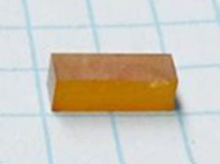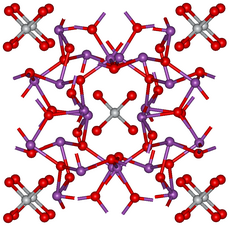Bismuth titanate
 Bi12TiO20 crystal[1]
| |
 Bi12TiO20 crystal structure[2]
| |
| Names | |
|---|---|
| Other names
Bismuth titanium oxide, dodecabismuth titanate[3]
| |
| Identifiers | |
3D model (JSmol)
|
|
| ChemSpider | |
PubChem CID
|
|
| |
| |
| Properties | |
| Bi12TiO20 | |
| Molar mass | 2875.62 |
| Odor | odorless |
| Density | 9.03 g/cm3[2] |
| Melting point | 875 °C (1,607 °F; 1,148 K) Decomposes to Bi4Ti3O12 and Bi2O3[4] |
| insoluble | |
| Structure | |
| body-centered cubic, cI66[4][2] | |
| I23, No. 197 | |
| Related compounds | |
Other cations
|
Bismuth silicon oxide |
Except where otherwise noted, data are given for materials in their standard state (at 25 °C [77 °F], 100 kPa).
| |
Bi4Ti3O12 crystal structure[5]
| |
| Names | |
|---|---|
| Other names
Bismuth titanium oxide
| |
| Identifiers | |
3D model (JSmol)
|
|
| ChemSpider | |
| EC Number |
|
PubChem CID
|
|
| |
| |
| Properties | |
| Bi4Ti3O12 | |
| Molar mass | 1171.5 |
| Odor | odorless |
| Density | 7.95 g/cm3[5] |
| insoluble | |
| Band gap | 3.5 eV |
| Structure | |
| Orthorhombic, oS76[5] | |
| Aba2, No. 41 | |
Except where otherwise noted, data are given for materials in their standard state (at 25 °C [77 °F], 100 kPa).
| |
| Identifiers | |
|---|---|
3D model (JSmol)
|
|
| ChemSpider | |
| EC Number |
|
PubChem CID
|
|
| |
| |
| Properties | |
| Bi2O7Ti2 | |
| Molar mass | 625.688 g·mol−1 |
| Odor | odorless |
| insoluble | |
Except where otherwise noted, data are given for materials in their standard state (at 25 °C [77 °F], 100 kPa).
| |
Bismuth titanate or bismuth titanium oxide is a solid inorganic compound of bismuth, titanium and oxygen with the chemical formula of Bi12TiO20, Bi 4Ti3O12 or Bi2Ti2O7.
Synthesis[edit]
Bismuth titanate ceramics can be produced by heating a mixture of bismuth and titanium oxides. Bi12TiO20 forms at 730–850 °C, and melts when the temperature is raised above 875 °C, decomposing in the melt to Bi4Ti3O12 and Bi2O3.[4] Millimeter-sized single crystals of Bi12TiO20 can be grown by the Czochralski process, from the molten phase at 880–900 °C.[1]
Properties and applications[edit]
Bismuth titanates exhibit electrooptical effect and photorefractive effect, that is, a reversible change in the refractive index under applied electric field or illumination, respectively. Consequently, they have potential applications in reversible recording media for real-time holography or image processing applications.[4][1]
See also[edit]
References[edit]
- ^ a b c Shen, Chuanying; Zhang, Huaijin; Zhang, Yuanyuan; Xu, Honghao; Yu, Haohai; Wang, Jiyang; Zhang, Shujun (2014). "Orientation and Temperature Dependence of Piezoelectric Properties for Sillenite-Type Bi12TiO20 and Bi12SiO20 Single Crystals". Crystals. 4 (2): 141. doi:10.3390/cryst4020141.
- ^ a b c Efendiev, Sh. M.; Kulieva, T. Z.; Lomonov, V. A.; Chiragov, M. I.; Grandolfo, M.; Vecchia, P. (1982). "Crystal Structure of Bismuth Titanium Oxide Bi12TiO20". Physica Status Solidi A. 74 (1): K17–K21. Bibcode:1982PSSAR..74...17E. doi:10.1002/pssa.2210740148.
- ^ Yaws, Carl L. (2015). The Yaws Handbook of Physical Properties for Hydrocarbons and Chemicals: Physical Properties for More Than 54,000 Organic and Inorganic Chemical Compounds, Coverage for C1 to C100 Organics and Ac to Zr Inorganics. Elsevier Science. p. 698. ISBN 978-0-12-801146-1.
- ^ a b c d Santos, D. J.; Barbosa, L. B.; Silva, R. S.; MacEdo, Z. S. (2013). "Fabrication and Electrical Characterization of Translucent Bi12TiO20 Ceramics". Advances in Condensed Matter Physics. 2013: 1–7. doi:10.1155/2013/536754.
- ^ a b c Van Uitert, L. G.; Egerton, L. (1961). "Bismuth Titanate. A Ferroelectric". Journal of Applied Physics. 32 (5): 959. Bibcode:1961JAP....32..959V. doi:10.1063/1.1736142.
